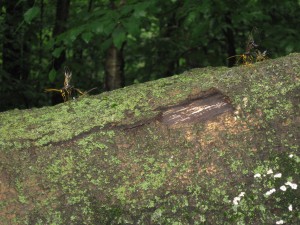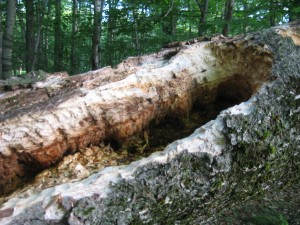sapiently This week marks three complete years in the woods; I moved up to the cabin full-time just as the private school year was coming to a close in 2008. Since that time I have spent ten seasons here; and a season apiece in the two most interesting cities in America, a winter in New Orleans and one in New York.
cheap neurontin One of the curious vows of the Benedictines is to promise to maintain stabilitas loci, stability of place, commitment to a spot. This is rarer, I suppose, than merely having an experience of nature, like Kerouac’s summer spent on top of Desolation Peak in the Cascades.
And it has some other lessons; a brief period in a place makes all seem lush and beautiful; the longer you spend the more you see how death is mixed into everything. I noticed a pair of pileated woodpeckers – astonishing, gargantuan woodpeckers the size of crows – shredding some of my dead trees. I recognized one of the logs they had pockmarked as the one where I had watched some ichneumon wasps drilling into the wood and laying eggs one June afternoon. The woodpeckers had ripped the entire log apart to get to the food inside.
I don’t know why I care about whether or not this wasp’s children – or larvae, I suppose – become bird-food or not, but the massacre of young, though one of the more efficient ways to get food (they are so helpless, after all), never seems pleasant to me. Watching sparrows fight desperately – and utterly futilely – to drive a snake off the tree where their young are nested is one of those equal-parts-true-and-horrible images of existence.
But death is shot through it all. The tree in the picture grew on the duff of death, dead leaves and trees and so forth; it itself is but a corpse now, which is to say, food; and the ichneumon wasps themselves are parasitic, and famously gruesome parasites to boot. Their young do not eat wood, but actually eat the borer larvae inside the wood. A nice page on ichneumon wasps contains a quotation from Darwin:
“I own that I cannot see as plainly as others do, and as I should wish to do, evidence of design and beneficence on all sides of us. There seems to me too much misery in the world. I cannot persuade myself that a beneficent and omnipotent God would have designedly created the Ichneumonidae with the express intention of their feeding within the living bodies of Caterpillars, or that a cat should play with mice.”
And a good essay, well worth reading, by Stephen Jay Gould on the relations of ichneumon wasps and goody-two-shoes theology. A brief, Christian answer to it is that a theology built on Crucifixion is not goody-two-shoes at all. The generation of life out of death is the Paschal mystery.


Post a Comment